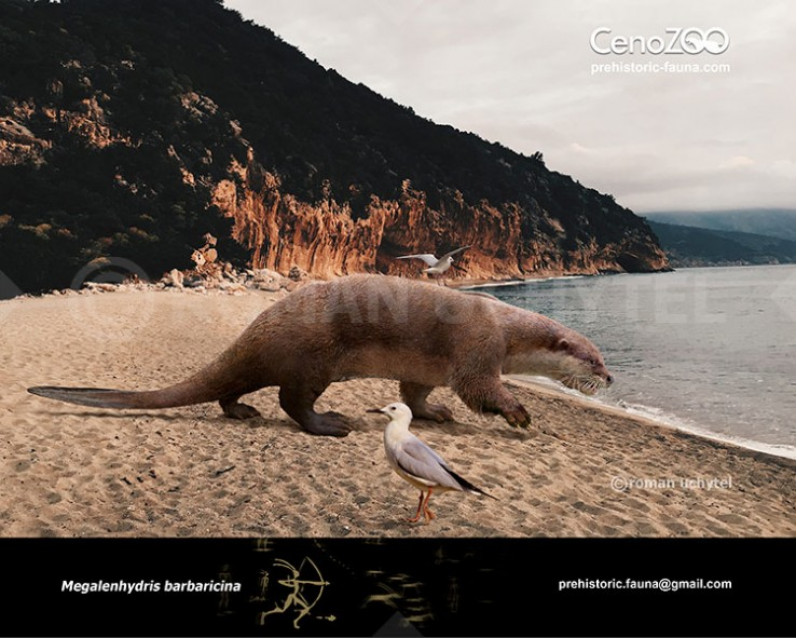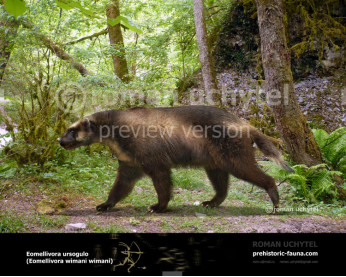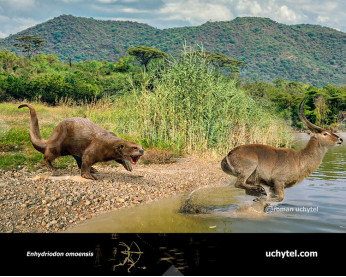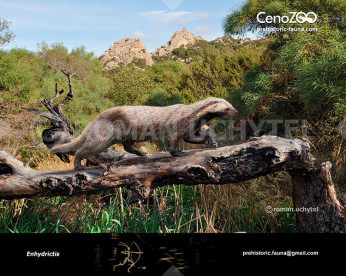Sardinian giant otter
2024720247Sardinian giant otter (†Megalenhydris (Willemsen & Maletesta, 1987))
Order: Carnivora
Family: Mustelidae
Subfamily: Lutrinae
Dimensions: length - 2,5 m, height - 60 сm, weight - 50-100 kg
Temporal range: Late Pleistocene of Sardinia
Megalenhydris barbaricina was larger than any living otter, exceeding the size of modern South American giant otters, which can reach two meters in length. The extinct Sardinian species of giant otter from the Late Pleistocene is one of four extinct otter species from Sardinia and Corsica. The others are Algarolutra majori, Lutra castiglionis and Sardolutra ichnusae. It is suggested to have ultimately originated from the much smaller European mainland species "Lutra" simplicidens. The structure of the teeth points to a diet of bottom dwelling fish and crustaceans. A special characteristic of the species is the flattening of the first few caudal vertebrae, this might point to a slightly flattened tail.
During the Middle-Late Pleistocene Corsica and Sardinia had their own highly endemic depauperate terrestrial mammal fauna which besides Megalenhydris included the dwarf mammoth (Mammuthus lamarmorai) the Sardinian dhole (Cynotherium sardous), a galictine mustelid (Enhydrictis galictoides), two other species of otter (Algarolutra majori and Sardolutra ichnusae) and a deer (Praemegaceros cazioti).
Sardinian giant otter (†Megalenhydris (Willemsen & Maletesta, 1987))
Order: Carnivora
Family: Mustelidae
Subfamily: Lutrinae
Dimensions: length - 2,5 m, height - 60 сm, weight - 50-100 kg
Temporal range: Late Pleistocene of Sardinia
Megalenhydris barbaricina was larger than any living otter, exceeding the size of modern South American giant otters, which can reach two meters in length. The extinct Sardinian species of giant otter from the Late Pleistocene is one of four extinct otter species from Sardinia and Corsica. The others are Algarolutra majori, Lutra castiglionis and Sardolutra ichnusae. It is suggested to have ultimately originated from the much smaller European mainland species "Lutra" simplicidens. The structure of the teeth points to a diet of bottom dwelling fish and crustaceans. A special characteristic of the species is the flattening of the first few caudal vertebrae, this might point to a slightly flattened tail.
During the Middle-Late Pleistocene Corsica and Sardinia had their own highly endemic depauperate terrestrial mammal fauna which besides Megalenhydris included the dwarf mammoth (Mammuthus lamarmorai) the Sardinian dhole (Cynotherium sardous), a galictine mustelid (Enhydrictis galictoides), two other species of otter (Algarolutra majori and Sardolutra ichnusae) and a deer (Praemegaceros cazioti).


-797x638.jpg)

-70x56.jpg)
-346x277.jpg)


-346x277.jpg)
